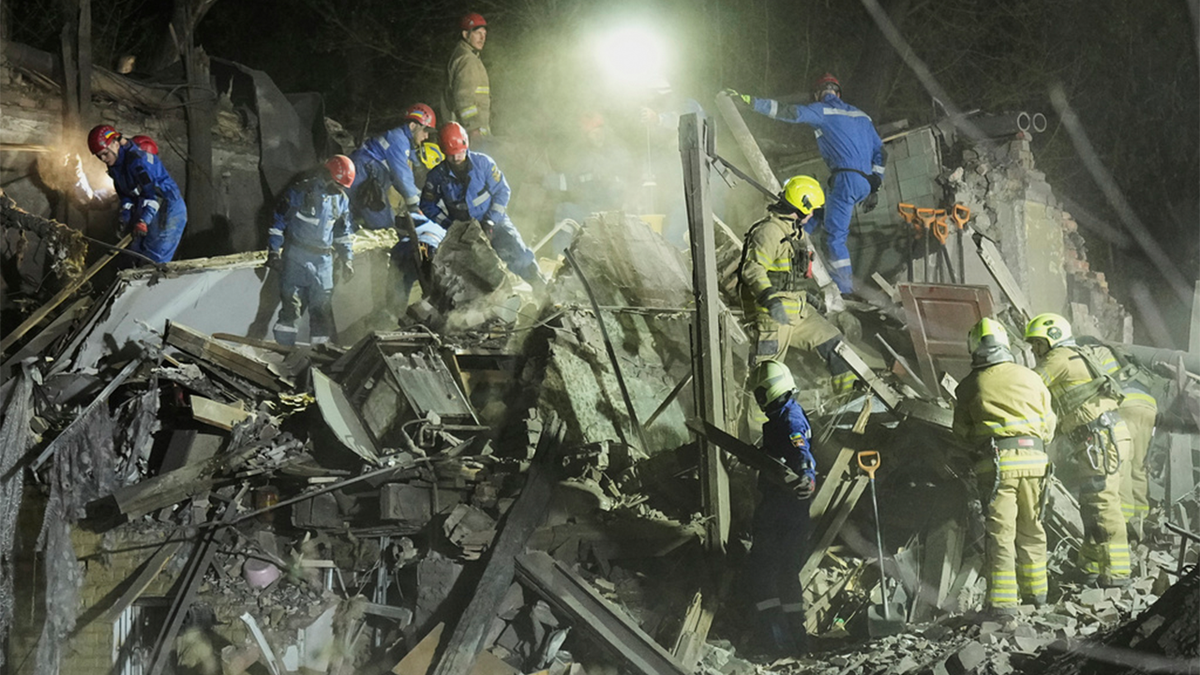INTERNACIONAL
Trump’s goodwill tested as Putin ignores peace efforts during Witkoff’s visit

President Donald Trump’s patience is being tested by Russian President Vladimir Putin, who launched a barrage of airstrikes on the Ukrainian capital city of Kyiv, killing 12 people and injuring nearly 100 more this week, one day ahead of Special Envoy Steve Witkoff’s fourth visit to Moscow.
Trump told reporters Friday he believes it is «possible» and even «very probable» his administration will negotiate a peace deal between Russia and Ukraine.
«I think, in the end, we’re going to end up with a lot of good deals, including tariff deals and trade deals. We’re going to make our country rich,» Trump said ahead of his departure for Rome. «We’re going to try and get out of war so that we can save 5,000 people a week. That’s what my aim is.»
Steve Witkoff meets with Vladimir Putin in St. Petersburg (Reuters )
TRUMP’S ‘STOP’ MESSAGE TO PUTIN ECHOES BIDEN’S ‘DON’T’ FROM 2022
Trump repeated that he has no deadline for a deal, only that one must be ironed out «as fast as possible.»
He made his comments one week after the U.S. threatened to abandon talks if Russia and Ukraine didn’t soon reach a deal and one day after Trump issued a direct message to Putin on social media to «stop» bombing Ukraine.
«I am not happy with the Russian strikes on KYIV. Not necessary, and very bad timing. Vladimir, STOP! 5,000 soldiers a week are dying. Let’s get the peace deal DONE,» he wrote.
Trump also conceded that his repeated claims from the campaign trail that he would have the war in Ukraine stopped within 24 hours of taking office were not based on realistic goals but were «figurative.»
«I said that as an exaggeration,» he told reporters, again blaming the war on his predecessor, President Biden.

The Friday, April 25, 2025, front page of the New York Post reacted to President Donald Trump telling Russian President Vladimir Putin to «stop» bombing Ukraine. (New York Post)
But it appears Trump’s verbal warnings to Putin have fallen on deaf ears, similar to the results of Biden’s verbal warnings. Trump has repeatedly accused Biden of being partly at fault for the war, though he has not explained why.
Former Moscow CIA Station Chief Dan Hoffman said he and other security experts repeatedly warned that, under the Biden administration, Ukraine was not sufficiently armed to adequately take on Russia.
«After failing to deter Putin’s invasion, the Biden administration just kept Ukraine in the fight but didn’t give Ukraine a chance to punch back fast enough or hard enough,» he said.
«There are three options,» Hoffman added, explaining how the U.S. can use its position as leverage over Moscow. «One, entice Russia. That’s what Trump is trying to do with trade deals and eliminating sanctions. And Putin has kind of plowed through that by rejecting confidence-building ceasefire deals.
TRUMP INSISTS UKRAINE-RUSSIA PEACE DEAL IS CLOSE, BUT MISTRUST IN PUTIN LEAVES EXPERTS SKEPTICAL
«The second option is to make Putin pay on the battlefield so that he feels so much pain he has to stop the invasion,» he added. «We convince Putin that we’re going to rearm Ukraine by saying, ‘We’ve offered you a great deal. You don’t want the deal, we’re going to arm the Ukrainians.
«The third option is to just walk away and let Europe fend for themselves and support Ukraine as much as they can. We would run the risk that Russia would take more territory from Ukraine. That would be a victory for Russia and its allies – China, North Korea and Iran.
«Let them do it, and then you’ll pay the price everywhere else in the world,» Hoffman warned, referring to China’s threats against Taiwan. «Americans don’t like to fight wars. OK, we don’t like to lose wars either.»

Ukrainian searchers clear rubble after a Russian ballistic missile attack in Kyiv, Ukraine, April 24, 2025. (AP Photo/Efrem Lukatsky)
NATO CHIEF SENDS MESSAGE TO RUSSIA: YOU ‘ARE NOT WINNING THIS’
An official with knowledge of the talks told Fox News Digital Friday that «Ambassador Witkoff is in Russia to meet with President Putin as part of President Trump’s efforts to make peace.
«It’s long past time for the death and destruction to stop, to move past the failed strategies of the past and for an end to this devastating conflict,» the official added without commenting on the «substance of negotiations.»
A report by Axios this week suggested the White House had extended a «final offer» to Ukraine and Russia that called on Kyiv to recognize Russia’s occupation of nearly all the Luhansk region and the occupied areas of the Donetsk, Kherson and Zaporizhzhia regions.
It also said the U.S. would agree to recognize Crimea, which Putin illegally seized from Ukraine in 2014, as now legally a part of Russia, and that Washington would lift sanctions.

A woman with two children cries near a makeshift memorial on a playground while honoring the memory of a Russian missile strike’s victims April 6, 2025, in Kryvyi Rih, Dnipropetrovsk Oblast, Ukraine. (Mykola Domashov/Suspilne Ukraine/JSC «UA:PBC»/Global Images Ukraine via Getty Images)
Neither the White House nor the National Security Council responded to Fox News Digital’s repeated questions about whether there will be consequences for Putin should he fail to enter into an agreement with Ukraine.
CLICK HERE TO GET THE FOX NEWS APP
The administration also did not comment on why it believes Putin wants to enter into an agreement with the U.S. when security officials have repeatedly warned otherwise.
Ukrainian President Volodymyr Zelenskyy has already said he will not acknowledge Crimea as a part of Russia but rather as Ukrainian land illegally occupied by Russia.
Zelenskyy also on Thursday posted a 2018 «Crimea declaration» by Trump’s first-term Secretary of State, Mike Pompeo, which said, «No country can change the borders of another by force» in a move to signify Trump’s apparent position change that now favors Russia.
INTERNACIONAL
Obama Presidential Center deposits just $1M into $470M reserve fund aimed to protect taxpayers

NEWYou can now listen to Fox News articles!
When the Obama Foundation snagged a sweetheart deal to build its beleaguered Obama Presidential Center on a Chicago public park, it pledged to create a $470 million reserve fund to spare taxpayers should the project ever go belly up.
But new tax filings show the foundation has only deposited $1 million into the fund and has not added to it in years, with critics saying the empty promise could potentially leave Chicagoans on the hook for hundreds of millions of dollars.
Under its agreement with the city, the foundation was required to create the fund, known as an endowment, in order to take control of the sprawling 19.3-acre section of Jackson Park — often described as Chicago’s Central Park equivalent — where the complex is now slowly rising.
The foundation ultimately secured the public land for just $10 in 2018, under a 99-year deal.
Former President Barack Obama is pictured next to construction of the Obama Presidential Center in Chicago, Illinois, a project facing delays, soaring costs and mounting scrutiny over its finances. (Scott Olson/Getty Images; REUTERS/Vincent Alban)
OBAMA LIBRARY, BEGUN WITH LOFTY DEI GOALS, NOW PLAGUED BY $40M RACIALLY CHARGED SUIT, BALLOONING COSTS
But when former President Barack Obama and former First Lady Michelle Obama turned the sod at the site in September 2021, just $1 million — or 0.21% of the pledged funds — had been deposited into the endowment, and that figure has remained unchanged ever since.
With construction progressing at a snail’s pace and costs ballooning from an original estimate of $330 million to at least $850 million, the lack of progress on the promised endowment has fueled fears the Obama Presidential Center could leave taxpayers holding the can if finances spiral into the red.
It comes as the Obama Foundation’s latest tax return shows its finances under strain with revenue swinging wildly year to year, fundraising shortfalls and unfulfilled donor pledges.
On news that the endowment has largely remained unfunded, Illinois GOP Chair Kathy Salvi slammed the project as an «abomination» while blasting Democrats for potentially exposing taxpayers with the deal.
«It should come as no surprise that the Obama Center is potentially leaving Illinois taxpayers high and dry — it’s an Illinois Democrat tradition,» Salvi told Fox News Digital in a statement. «Democrats in this state, when not going to prison for corruption, treat taxpayers like a personal piggy bank giving sweetheart deals to their political benefactors.»

The Obama Presidential Center under construction in July. (Fox News Digital)
Scholar sounds alarm
Richard Epstein, a University of Chicago law professor emeritus and a New York University law professor, has raised concerns about the endowment for years and advised the local nonprofit Protect Our Parks with legal challenges to try to stop the Obama Center’s construction.
Epstein argues the foundation’s failure to fund its endowment confirms his long-held view that the city never should have signed over the large section of Jackson Park.
«They put a million dollars into a $400 million endowment, so it’s endowed. That gets you in jail as a securities matter,» Epstein told Fox News Digital. «An endowment means that you have the money in hand… But they have nothing. They just have the same $1 million that they put in in 2021 as far as I can tell. So I regard this as something of a public calamity.»
An endowment is a pot of money meant to earn enough interest each year to cover operating costs without touching the principle in order to avoid the taxpayer stepping in.
«Without an endowment, they’ll have to scramble every year to cover $30 million in operating costs,» Epstein said. «The whole point of an endowment is to avoid that volatility. They just haven’t endowed it. Of that I’m 100% sure.»
Epstein argues that if the foundation or center falters, the public could be saddled with traffic rerouting costs, environmental impacts, or even the bill for an incomplete building.
«Nobody knows exactly who is responsible for what if the project is abandoned or incomplete,» Epstein said. «There is a risk that the public will then have to bear that loss because the foundation won’t have the money.»
Epstein said the city has effectively looked the other way, declaring the foundation «compliant» on the endowment despite only $1 million ever being deposited. Proof, he argues, that officials never intended to enforce the requirement.
The Obama Foundation told Fox News Digital that it will be making «significant investments in the endowment in the coming years» as it has been prioritizing fundraising for the center and leadership programs.
«The Obama Presidential Center is fully funded and it will open in the spring of 2026,» a spokesperson for the foundation said.
CharityWatch, a nonprofit watchdog, told Fox News Digital that the foundation technically complied with its agreement by creating an endowment because the deal never set a dollar figure. The group also said that the foundation remains «well-funded» overall while also acknowledging the pledge risks, volatility and lack of a real endowment.

An aerial view shows construction of the Obama Presidential Center in Jackson Park, Chicago, Illinois, where costs have soared and questions remain about the project’s funding. (Scott Olson/Getty Images)
While the foundation’s agreement with the city required it to create an endowment, it did not specify an amount. The $470 million figure was being reported on as the city council deliberated on the deal and the foundation committed to that sum in its 2020 annual report.
In 2021 documents, the foundation said that first-year operating costs would be as much as $40 million. By that math, the center would actually need an endowment of between $800 million to $1 billion to fund operations without tapping the principle.
It’s also unclear how much revenue the foundation expects to generate each year.
Epstein said the lack of funds has long been the project’s Achilles heel. Without the endowment it promised, the project’s financial underpinning remains shaky, he said.
CHICAGO RESIDENTS CALL OBAMA PRESIDENTIAL CENTER A ‘MONSTROSITY,’ FEAR THEY’LL BE DISPLACED: REPORT
Despite financial pressures, the Obama Foundation has already spent about $600 million constructing the center, which aims to honor former President Barack Obama’s political career and be a civic hub. It consists of a 225-foot-tall museum, a digital library, conference facilities, a gymnasium and a regulation-sized NBA court. It will also house the Obama Foundation.
The new tax filings show the foundation ended 2024 with $116.5 million in cash, down nearly $80 million from the year before, while still owing about $234 million in construction costs. Of the funding gap, $216 million comes from firm pledges — promises of future donations — while another $201 million is tied up in conditional pledges that may never materialize if benchmarks aren’t met.
Epstein said the foundation’s financial assurances ring hollow, because a large chunk of the money it counts on is tied up in pledges and credit rather than cash in hand — leaving the center vulnerable to donor fatigue and year-to-year uncertainty.
WATCH: The Brian Kilmeade Show: Obama Presidential Center rocked by $40M racial bias lawsuit
Public trust doctrine
In the Protect Our Parks lawsuit, Epstein argued that handing Jackson Park to the Obama Foundation violated the public trust doctrine — which bars cities from giving away public land without a clear public benefit. The plaintiffs said the city gave away land worth nearly $200 million without securing enforceable returns for taxpayers.
However, U.S. District Judge John Robert Blakey, an Obama appointee, dismissed the case in 2019, ruling that the Obama Center qualified as a public use and that courts should defer to the city’s determination. The Seventh Circuit upheld the dismissal in 2020 and various other challenges by the plaintiffs have also failed on the public trust doctrine argument.
Epstein now points to the foundation’s failure to fund its promised endowment as proof the project never truly met the public benefit test and that a core part of his argument was valid.
As well as not being able to fill the endowment, the foundation is also financing a $250 million revolving credit line that it has yet to draw down but is costing the foundation hundreds of thousands of dollars in annual fees, according to the tax filings.

Illinois Governor J.B. Pritzker (L) joins former U.S. President Barack Obama and former first lady Michelle Obama in a ceremonial groundbreaking at the Obama Presidential Center in Jackson Park on Sept. 28, 2021 in Chicago, Illinois. At the time, around $1 million was in the endowment and it has remained relatively the same since. ( Scott Olson/Getty Images)
Easing oversight
Epstein argues the endowment shortfall is just one example of how the project has skirted safeguards.
Its 99-year deal with the city was rebranded as a «use agreement,» instead of a land lease, a legal pivot that he said let the city sidestep public-trust oversight and other regulatory checks.
The move grew out of an earlier fight over filmmaker George Lucas’s bid to build a Museum of Narrative Art on the lakefront. In 2016, a federal judge ruled the city’s plan to hand Lucas a 99-year lease of public parkland violated the public trust doctrine, sending Lucas packing for Los Angeles.
When the Obama Foundation arrived the following year, city officials adopted the new user agreement label. The terms were effectively the same — exclusive control for nearly a century in exchange for $10 — but by calling it a «use agreement,» the city claimed it no longer triggered the same scrutiny.
CLICK HERE TO GET THE FOX NEWS APP
Epstein called it a textbook case of bending the rules. «You can’t get out of a government regulatory relationship by changing the name on something,» he said.
Epstein said the foundation’s finances have never been fully scrutinized and his team was never allowed to examine the center’s internal records — from construction contracts to day-to-day statements — leaving the true state of its fundraising and shrouded in secrecy.
«They’ve gotten a free pass on both the environmental side and the financial side,» Epstein said. «Unless somebody cracks open the books, nobody really knows if they can actually fund this project. And if they can’t, it’s the public that will be left holding the bag.»
The offices of Mayor Brandon Johnson, Gov. J.B. Pritzker, the Democratic National Committee and the Democratic Party of Illinois did not respond to requests for comment.
barack obama,politics,chicago,democratic party,republicans,museums exhibits,education,presidential,michelle obama,law
INTERNACIONAL
Alerta en Venezuela: afirman que EE.UU. prepara ataques contra narcos dentro del país caribeño

Estados Unidos y Venezuela, con negociaciones en Medio Oriente
Estados Unidos,Venezuela,Donald Trump,Nicolás Maduro,Narcotráfico,Últimas Noticias
INTERNACIONAL
Philadelphia DA goes into tirade about ‘fascist’ Trump, ‘Hitler’ when confronted at park in viral video

NEWYou can now listen to Fox News articles!
Progressive Philadelphia District Attorney Larry Krasner launched into a rant when confronted by a young Republican activist in a local park in a video that has since gone viral.
«Donald Trump is a fascist,» Krasner said during the confrontation. When prompted to elaborate on what he meant by the remark, Krasner instead deflected and continued his tirade.
«You’re un-American, Frank. You’re un-American,» Krasner repeated in the video. «You’re anti-American.»
Frank Scales, the man behind the camera, responded, «I’m a resident of this city who cares about public safety. Why are you calling me un-American?»
SOROS-LINKED DA WARNS TRUMP AFTER DC CRIME CRACKDOWN: ‘BETTER NOT TRY IT IN PHILLY’
Philadelphia District Attorney Larry Krasner was seen in a viral video lambasting President Donald Trump as a «fascist.» (Matthew Hatcher/Reuters; Ken Cedeno/Reuters)
«Because you support people who support hate,» Krasner replied. «You don’t understand what it means to be a fascist, what people like Adolf Hitler do, how spreading hate, which is something that, frankly, the people you admire do, gets us closer to that.»
Krasner then got personal, saying that Scales was «a 22-year-old who knows nothing [about what] he’s talking about» and called Scales’ outlet, Surge Philly, a «fake, non-existent paper.»
«[We] went with the goal of talking to Krasner (an incumbent public servant) about why we weren’t allowed in his town hall and to understand why he calls Republicans ‘fascist.’ The idea was to have a civil conversation with Larry in a public space, but he is incapable of civil discourse,» Surge Philly said in a statement to Fox News Digital. «If there’s anything about Larry Krasner we’d like others to know, it’s that he’s a progressive district attorney funded by out-of-state billionaires to advance an agenda not in the interest of the people he serves.»
During the encounter, Krasner referenced an incident in which Scales disrupted a meeting in the city.
On Sept. 16, Scales participated in what the outlet WCAU described as a «brief disruption» during a town hall that Krasner was holding at the Salt & Life Church.
This was part of a series of talks the district attorney planned to discuss with the public the possibility of President Donald Trump deploying the National Guard to Philadelphia, as he had in Washington, D.C., and Los Angeles, WPVI-TV reported.

Philadelphia District Attorney Larry Krasner speaks during a news conference in Philadelphia, on Jan. 31, 2022. (AP Photo/Matt Rourke, File)
The Trump administration has yet to announce plans to deploy the National Guard to Philadelphia. However, Pennsylvania Gov. Josh Shapiro said earlier this month that the state is «prepared» to respond if Trump were to send troops.
«I can tell you that we are prepared,» Shapiro said, according to WPVI. «We are prepared should they try to deploy the National Guard against my will in any community across Pennsylvania.»
SHAPIRO CHIDES TRUMP OVER RESPONSE TO CHARLIE KIRK ASSASSINATION
«Fascists are going to be fascists. What can I say?» Krasner said at the town hall, according to WCAU. He then went on to trash the «Pennsylvania Legislature and its MAGA members,» according to the outlet.
«The fundamental premise of the United States is supposed to be that all people are created equal. It’s a deep belief in equality,» Krasner reportedly added. «These people don’t believe in equality at all. They don’t believe in equality of folks. They don’t believe in gender equality. They’re absolutely just as hateful towards women as they are on the issue of race. These are people who agree with Adolf Hitler.»
At that moment, Scales stood up and yelled, «Lie!» He then added, «People like you are responsible for the death of Charlie Kirk. Stop calling them fascists,» according to WCAU.
BYRON DONALDS REBUKES ‘SQUAD’ MEMBER OVER ‘FASCIST’ SLUR: ‘DO I LOOK LIKE A MEMBER OF THE THIRD REICH?’

Philadelphia District Attorney Larry Krasner speaks in Philadelphia, on Jan. 11, 2024. (AP Photo/Matt Rourke)
Scales spoke about the incident in a video on X, saying that he did not attend the meeting with the intention of disrupting the district attorney. It was only after he was told that questions at the town hall had to be written on cards «so they can be vetted and read by a moderator» that he determined the event was no more than a «publicity stunt.»
Two days later, on Sept. 18, Scales attempted to attend another one of Krasner’s town halls but was allegedly denied entry.
CLICK HERE TO GET THE FOX NEWS APP
Krasner, a vocal Trump critic, on Thursday urged officials to condemn the alleged politicization of the Justice Department, comparing it to Watergate.
«Justice requires evenhandedness and impartiality in order to function effectively. Sadly, Trump’s actions this week are another example of his toxic assault on constitutional norms,» Krasner said in a statement. «I invite other elected officials to speak up, especially local and state prosecutors, against this egregious politicization of the Justice Department. The ongoing assault on our democracy by the Trump administration is not normal and must be called out at every opportunity.»
Fox News Digital reached out to Scales and Krasner for comment.
politics,philadelphia,donald trump

 SOCIEDAD3 días ago
SOCIEDAD3 días agoQuiénes son los cuatro detenidos por el triple femicidio de Florencio Varela

 CHIMENTOS20 horas ago
CHIMENTOS20 horas agoMario Massaccesi confesó toda la verdad detrás de su fuerte pelea con Paula Bernini

 POLITICA2 días ago
POLITICA2 días agoPatricia Bullrich: “Kicillof tiene que hacerse cargo del problema enorme de inseguridad que tiene la provincia de Buenos Aires”
















